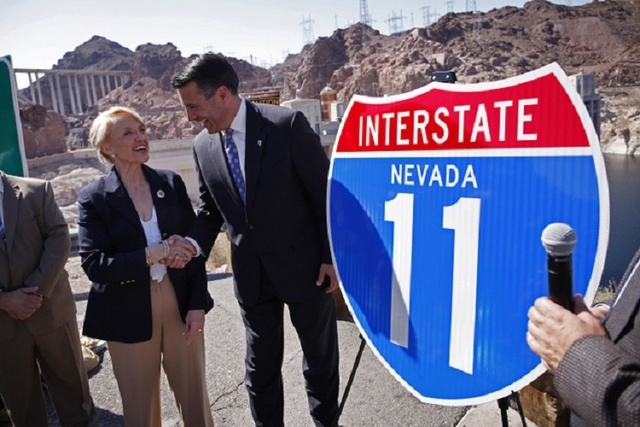Nevada board approves bid for I-11 infrastructure
It won’t be long before Interstate 11 gets its own concrete.
The highway designated between Phoenix and Las Vegas is just a route for now — lines on a map traced over U.S. Highway 93. Only a small portion of I-11 will have all-new infrastructure, the bypass around Boulder City.
On Monday, the Nevada Transportation Department board approved a bid awarding an $83 million contract to Fisher Sand & Gravel to build the first sliver of that new infrastructure.
It will be the first major project in Southern Nevada for the Dickinson, N.D.-based company, which was the contractor for the massive Galena Creek Bridge in Northern Nevada.
NDOT’s project is the smaller portion of a two-phase program that will occur simultaneously with an effort directed by the Regional Transportation Commission of Southern Nevada. The state’s project involves the 2.5 miles closest to Las Vegas on I-11’s Boulder City bypass route. A bid for the longer portion, about 12.5 miles north and east from the Mike O’Callaghan-Pat Tillman Memorial Bridge over the Colorado River, is expected to be awarded at the Transportation Commission’s meeting Thursday. The apparent low bidder for that project is Las Vegas Paving.
Construction on both phases is expected to begin by May with a kickoff celebration ceremony anticipated in April. Completion is expected in early 2018.
The state’s project will include building the four-lane concrete interstate highway between Silverline Road and Foothill drive with a full diamond interchange at Railroad Pass with a loop ramp. The highway will lead to a bypass loop around Boulder City. On the north end of the project, the highway will connect to what is now U.S. Highway 95 and Interstate 515.
As U.S. Highway 93, the route currently serves an estimated 34,000 vehicles a day through Boulder City, including heavy truck traffic.
The state opted for a concrete surface instead of asphalt. NDOT District Engineer Mary Martini said federal studies show concrete ultimately costs 13 percent to 28 percent less than asphalt because of its long-term durability. Martini said concrete reduces rutting and potholes.
The contract also includes building a highway interchange with U.S. Highway 95 to Searchlight, the creation of a 1.5-mile asphalt frontage road linking Henderson with the Railroad Pass interchange, the replanting of 20,000 cacti and the installation of 5 miles of tortoise fencing.
The project also will reconnect railroad tracks severed by the existing highway and the construction of a 180-foot steel-truss bridge allowing the freeway to pass under the train tracks. A pedestrian bridge will connect Henderson’s trail system to the River Mountains Loop Trail.
A 1,200-foot-long, 28-foot-wide, cast-in-place textured, multicolored concrete wall coated with anti-graffiti film with graphics depicting the construction of Hoover Dam will be a visual element of the project.
The state project is expected to employ 180 workers on-site. Two lanes of traffic will be maintained through the duration of the project.
The state’s bid process was the first using a formula to compare proposals for concrete and asphalt road surfaces based on the expected life expectancy of the materials.
Follow @RickVelotta on Twitter. Contact reporter Richard N. Velotta at rvelotta@reviewjournal.com or 702-477-3893.

Additional maps:
Alternate routes through Nevada considered for Interstate 11
Routes through the Las Vegas Valley
Routes considered through Phoenix and western Arizona
Ports and sources of freight served by Interstate 11 project

















